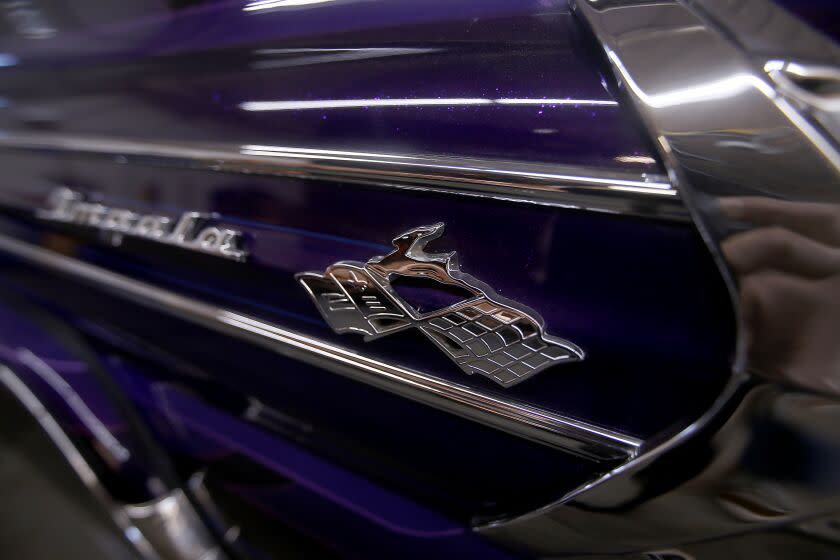Editorial: Los Angeles is the chrome capital, but chemical behind the shine is too dangerous to keep using

Southern California has the nation’s highest concentration of chrome platers, the metal shops that dip car bumpers, plumbing fixtures, airplane parts and other products in large industrial tanks to coat them with a shiny, mirror-like finish.
But the chemical they have long used, hexavalent chromium, is a serious health hazard, with no safe level of exposure. It's a pollutant that’s about 500 times more carcinogenic than the particulate matter in diesel exhaust, and its release into neighboring communities has been a problem for decades. More than two-thirds of the 114 chrome-plating facilities that use hexavalent chromium in California are within 1,000 feet of homes, schools, hospitals and other sensitive locations, and about 10% are within 65 feet, according to air quality officials.
These operations shouldn’t be allowed to keep dumping such a dangerous chemical into the air, creating a health threat to their neighbors. The California Air Resources Board should move forward with a proposal to ban its use in chrome-plating, while doing more to help small businesses make a successful transition to safer alternatives.
Air monitoring in recent years has detected alarmingly high levels of hexavalent chromium, also called chromium-6, near metal-finishing facilities in communities like Paramount that already have some of the region's highest cancer risk from air pollution and where residents are exposed to higher concentrations that are not picked up in monitoring data, according to air quality regulators.
State and local regulations to reduce emissions from chrome-platers and other metal-processing facilities have done too little to address this longstanding environmental injustice. More than 73% of chrome-plating facilities in California are in disadvantaged communities hard-hit by multiple sources of pollution. It’s no longer good enough to incrementally reduce such a highly toxic chemical. Some pollutants are so dangerous that they need to be eliminated.
Opponents of a chrome-plating ban continue to question the health concerns. While it's notoriously difficult to ascribe someone's cancer to a singular cause, regulators can quantify the broader threat by calculating the chances of contracting cancer over a lifetime of exposure. Large chrome-plating facilities have an estimated cancer risk of about 213 additional cases per 1 million people, far above the limit of 10 per 1 million recommended by health experts. Ending the use of hexavalent chromium would reduce that to zero.
California regulators long ago banned other toxic air pollutants like perchloroethylene used by dry cleaners, which was replaced with less harmful alternatives. We don’t use leaded gasoline and paint, asbestos in buildings or allow smoking in restaurants and airplanes anymore, and we're all safer and healthier for it.
The Air Resources Board's proposal, which received an initial hearing last month and is scheduled for final approval in May, would ban new hexavalent chromium plating operations starting in 2024 and phase the chemical out from existing operations in two stages.
Decorative chrome plating facilities, smaller shops that deposit a thin layer of chromium on products like plumbing fixtures, wheel rims and car bumpers, would have to stop using hexavalent chromium by 2027. Larger plating facilities, which use hard chrome plating and acid anodizing to coat things like landing gears and other high-performance aerospace parts with a thicker layer of chromium to increase durability and corrosion resistance, would have until 2039; in the interim, they would be subject to additional rules, including tougher emissions limits.
The rule would encourage the development of less toxic alternatives for aerospace applications and push decorative platers to switch to one that is already available: trivalent chromium, which is not a known carcinogen. It produces a slightly darker-looking finish but is used by four decorative chrome-plating facilities in California, showing the transition is doable. State lawmakers have committed $10 million in assistance to help chrome platers switch if the rule is approved. The Air Resources Board estimates that the rules will cost each smaller, decorative plating facility about $323,000, and the larger hard plating and anodizing facilities about $4 million each.
It's no surprise that the ban is opposed by the metal-plating industry, which employs about 4,600 people in California. Industry representatives argue that they cannot afford, nor will customers accept, a switch to trivalent chromium, and say banning hexavalent chromium will shift production to other states and countries without California’s tough regulations.
Those complaints seem to underestimate the capacity of businesses to innovate and adapt when it's time to stop using outdated, health-damaging technology. Decorative chrome customers should be able to adjust to a slightly different shine.
But the chrome-plating industry does raise legitimate concerns about the ban's timeline. The proposal would give smaller businesses, the roughly 50 decorative shops, just a few years to make the transition while giving bigger platers 15 years. Air quality officials should move ahead with the ban but consider giving smaller facilities more time to phase out hexavalent chromium if they agree to more stringent pollution controls and emissions testing in the meantime.
There's no question that chrome plating has been important in this region, a longtime hub of the aerospace industry and a cradle of car culture that prizes gleaming chrome bumpers and rims. But that lustrous shine shouldn't come at the expense of people's health, especially when there is a safer alternative.
This story originally appeared in Los Angeles Times.

